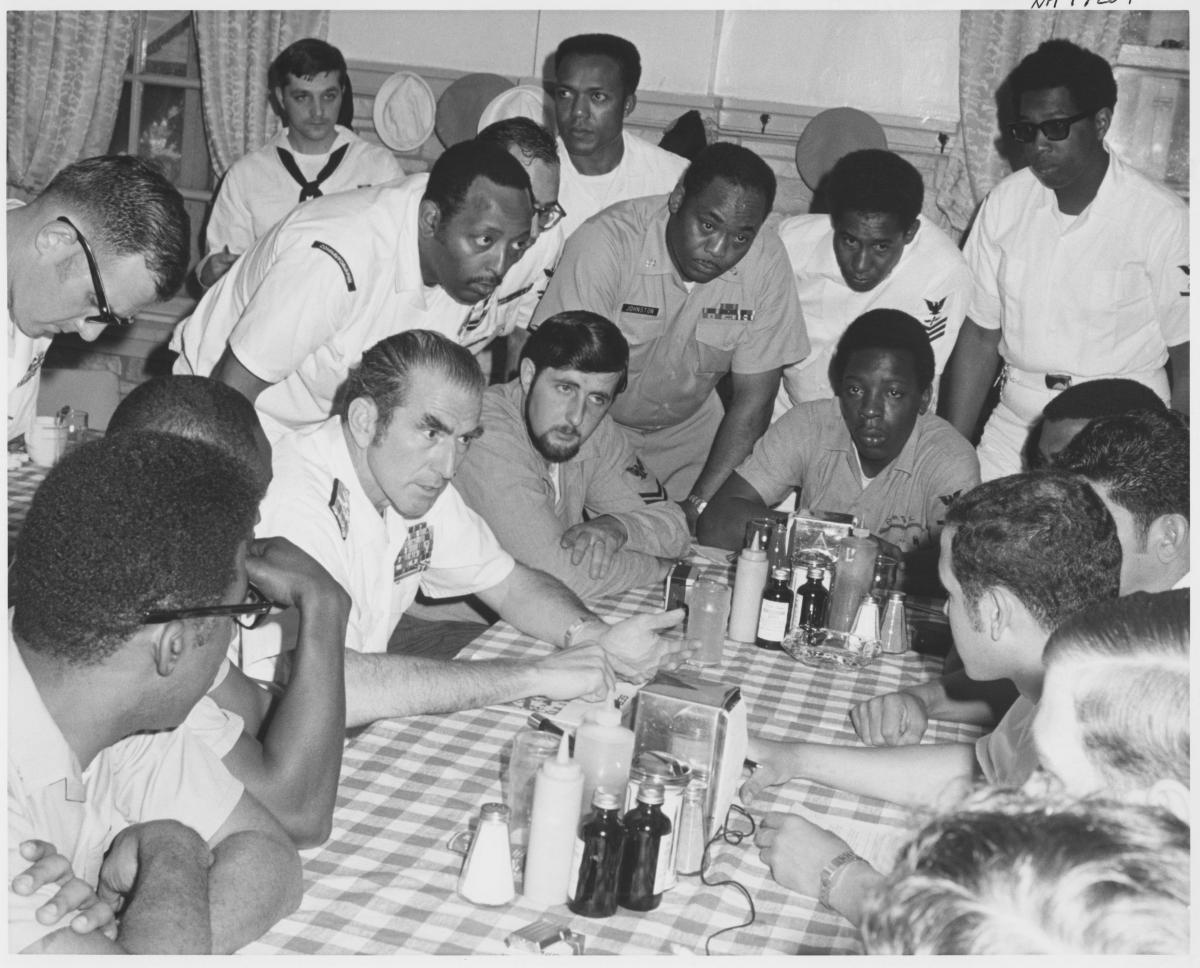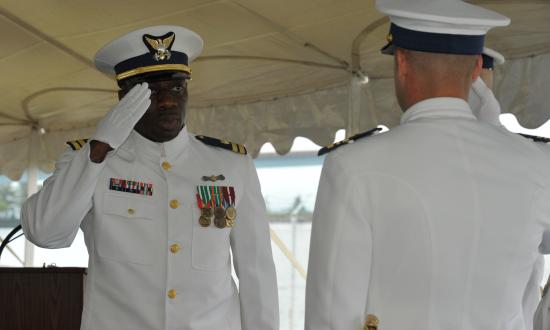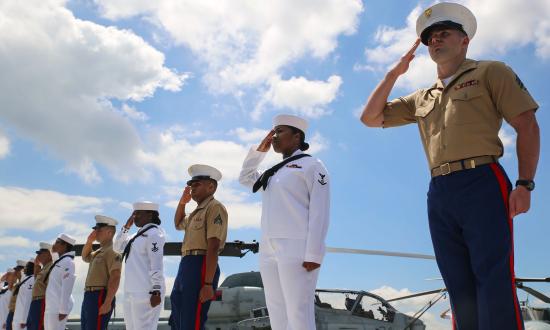"Not everything that is faced can be changed, but nothing can be changed until it is faced."— James Baldwin
In 23 years of naval service, I have learned that candid and open discussions that welcome dissenting or different opinions can be an effective catalyst for change; it is no different for racial injustice. If the Navy truly believes that inclusion and diversity are critical to warfighting readiness, now is the time for real progress, building on the foundation laid by Admiral Elmo Russell “Bud” Zumwalt Jr., 19th Chief of Naval Operations.
In 1970, in the wake of Secretary of the Navy John Chafee’s ALNAV 51 on equal opportunity, Admiral Zumwalt released a trailblazing document, Z-Gram 66: “Equal Opportunity in the Navy.” In this message, he noted, “What struck me more than anything else was the depth of feeling of our Black personnel that there is significant discrimination in the Navy.”1
Fifty years later, I was both encouraged and disheartened to read the 3 June statement from the 32nd CNO, Admiral Michael Gilday, where he said, “I can’t imagine the pain and disappointment and anger that many of you felt when you saw that [the choking of George Floyd].”2 I was encouraged because Admiral Gilday said what he said; disheartened because I doubt anyone expected this conversation to carry forward to 2020. After five decades of Navy innovation, progress, and change, we find ourselves back where we started. Some may feel things have gotten better, but I’m certain a great number of black officers in the Navy feel little has truly changed.
The foundations of naval leadership are laid through commissioning programs and are built on through other training and experiences over the full span of an officer’s career. However, this training and experience have never considered the black officer’s additional burden.
Imagine standing in front of your team. Division, department, command—it does not matter the scope. You are standing in front of them as you prepare to head into harm’s way: a deployment to a part of the world with global competitors who actively oppose what your team represents. You stand in front of that team because your oath to the Constitution is the burden you chose, bearing true faith and allegiance to it, freely, without mental reservation, to faithfully discharge the duties of your office.
Now consider the perspective of the black officer standing in front of his or her team today. Individually, we carry the burden of the Black American experience as a generational post-traumatic stress disorder that has gone untreated for more than 400 years. Imagine not only leading your sailors in daily freedom of navigation operations on a $1.8 billion warship in the South China Sea, but also dealing with the exhaustive mental drain of cumulative questioning. Black officers often bear the weight of being labeled examples of black excellence or black incompetence. Imagine not only having to fly a $100 million aircraft over an adversary’s country to drop ordnance or conduct operations at risk of being shot down, but also experiencing the persistent emotional drain of questioning whether you are being judged on the content of your character and performance or the color of your skin.
This is happening behind the mask that Coast Guard Commander Marcus Canady discusses in his recent article.3 Ironically, we wear the mask as a form of protection; in reality, we want to be seen and heard—as equal. We want the earned opportunity to qualify in a primary warfare designator without prejudice because of where we went to school or our commissioning source. We need our commanders and commanding officers to challenge, counsel, and mentor us months before a fitness report debrief that reflects that we are below average. Like any sailor, we want divisional or departmental leaders to get to know us beyond any preconceived notions that prevent them from being involved in our professional development.
Within the last year, the Navy has introduced the “Culture of Excellence,” “Signature Behaviors of the 21st Century Sailor,” and “U.S. Navy Inclusion and Diversity Goals & Objectives.”4 The three documents provide an outstanding framework to aid commanders and commanding officers in the difficult task of building an enduring culture of excellence. However, the deep and complementary conversations are long overdue. Progress requires engagement on this issue at every level of the chain of command. We will get there only when leaders are willing to listen, reflect, learn, and adapt—through action.
For far too long, black officers have seen top-down inclusion and diversity policy revisions that commanders and commanding officers are just expected to implement. The Navy at all echelons of leadership should take the opportunity presented at this critical moment to generate real momentum for concrete action toward a more inclusive fleet. This will require more sustained effort than having a cup of coffee, small group discussions, all-hands calls, emails to the crew, or monthly ethnic celebrations. One idea is to hold type commanders accountable for measurable inclusion and diversity benchmarks across the leadership continuum, from midshipman to flag officer.
We already know what it looks like when our top admiral communicates an expectation and the institution does not follow his lead. In 1972, two years after Z-66, Admiral Zumwalt addressed more than 80 admirals and Marine Corps generals on their resistance: “I am speaking to you. Through you, to the Navy’s entire command structure to emphasize again that this issue of discrimination must be faced openly and fully.”5 Assignment as a minority affairs officer, for example, was merely a collateral duty. This and other initiatives mandated in 1970 were never fully implemented by the Navy, contributing to conditions that resulted in “130 men assigned to the Constellation refus[ing] to board their ship . . . accusing the ship’s officers of ‘calculated racism.’”5 Similar racial disturbances occurred on two other ships during this period.
And what about the conversations that have happened and are continuing to happen in wardrooms, the chiefs mess, on mess decks, or behind closed doors? Recently, a retired naval officer and member of the U.S. Naval Academy Alumni Association Board of Trustees inadvertently communicated his biases to the world through social media.6 Although he apologized, his words reflect his thoughts at the time.
When I was a young petty officer, a chief petty officer publicly embarrassed me by using his positional authority to put me at attention. He refused to believe a black petty officer would know more than him about the ship’s equipment. As an officer candidate in ROTC, one of my white peers, out of anger and jealousy, told me I was selected for Seaman to Admiral-21 only because I was black. As a lieutenant, I was told that because I went to a Historically Black College and University and with my test scores, I “probably” wouldn’t make it as a nuclear-trained surface warfare officer. There are stories like this all across the Navy. Racial bias can be deceptive.
Let me be clear. If any officers are not performing up to the strictest standards of naval excellence, it is our duty to them individually and to the Navy as a whole to evaluate them accordingly. Black officers are not looking for a handout. We just want access to the same opportunities without senior officers in positions of influence impeding our progress—even if they do so unknowingly or unintentionally. Regardless of motive, an opportunity denied is denied just the same. The Navy’s efforts must be transparent and intentional, without any hint of a willingness to sacrifice quality for quantity in achieving our organization’s inclusion, diversity, or warfighting readiness objectives.
Leaders may need more training to show empathy or compassion. However, formal training is not required to personally care about this issue by applying the same level of leadership that one would any issue of this magnitude. All naval officers should display the same will and determination for mission accomplishment, and they should mirror that focus in the areas where it is desperately needed: listening, empathizing, learning, and adapting. Our One Navy Team of today has a moral obligation to ensure we are not talking about this issue in another 50 years.
1. ADM Elmo Zumwalt, USN, “Equal Opportunity in the Navy,” Naval Message CNO Z-66, 17 December 1970.
2. ADM Mike Gilday, USN, “CNO Message to Sailors,” 3 June 2020.
3. CDR Marcus Canady, USCG, “Racial Tensions in America Requires Intrusive Leadership,” U.S. Naval Institute Proceedings 146, no. 6 (June 2020).
4. ADM Mike Gilday, USN, “Culture of Excellence,” NAVADMIN 254/19, ADM John Aquilino, ADM Christopher Grady, ADM James Foggo, USN, “Signature Behaviors of the 21st Century Sailor,” February 2020; and Director, 21st Century Sailor, “U.S. Navy Inclusion and Diversity Goals and Objectives,” February 2020.
5. Drew Middleton, “Zumwalt Rebukes Top Navy Leaders on Racial Unrest,” The New York Times, 11 November 1972.
6. Ben Werner, “Naval Academy Alumni Board of Trustees Member Resigns after Facebook Outburst,” USNI News, 7 June 2020.






